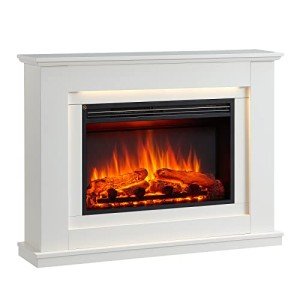A Comprehensive Guide to Small Fireplaces: Efficient Heating and Cozy Living
In a period where energy efficiency and space optimization are becoming significantly crucial, small fireplaces have become an enticing alternative to traditional, bulky hearths. These compact heating solutions use warmth and a focal point for any room, increasing both convenience and visual appeal. Traditional Fireplaces UK out the different types of small fireplaces, their benefits, setup considerations, and maintenance suggestions, eventually helping homeowners make informed choices when considering these lovely heating choices.
Comprehending Small Fireplaces
Small fireplaces use a variety of styles, consisting of electric, gas, ethanol, and wood-burning models. Fireplace Sale provides distinct benefits and style possibilities, making them ideal for different living areas.
Types of Small Fireplaces
| Fireplace Type | Description | Pros | Cons |
|---|---|---|---|
| Electric | Uses electrical energy to produce heat. Offers lots of designs, including wall-mounted and freestanding units. | - Easy to install - Low maintenance - No venting required | - Limited heat output - May incur greater electrical power costs |
| Gas | Burns natural gas or propane. Frequently readily Fireplace Online as logs in a traditional fireplace or modern designs. | - Efficient heat output - Cleaner than wood - Easy ignition | - Requires gas line installation - Some units need venting |
| Ethanol | Burns bioethanol, offering genuine flames without a chimney. | - Eco-friendly - Portable - No installation required | - Limited heat output - Higher fuel costs |
| Wood-Burning | Traditional fireplaces that burn fire wood. Typically utilized in more rustic settings. | - Great heat output - Rich atmosphere - Can be used during power failures | - Requires a chimney - Regular upkeep and cleansing |
Benefits of Small Fireplaces
- Area Efficiency: Small fireplaces are perfect for apartments, condominiums, and smaller sized homes. They make the most of heat without taking up excessive flooring area.
- Affordable Heating: In specific cases, small fireplaces can supplement central heating systems, reducing total energy costs while creating a more comfortable environment.
- Ambiance and Aesthetics: They supply a welcoming centerpiece to a space, creating a cozy environment ideal for relaxation and social events.
- Adaptability: Available in numerous designs and styles, small fireplaces can complement any design, from modern minimalist to rustic traditional.
Setup Considerations
When pondering a small fireplace, installation is a crucial aspect that can affect the option of design. Below are valuable considerations:
- Local Regulations: Building codes can vary by area; always inspect local guidelines before installation.
- Ventilation Needs: Depending on the type, small fireplaces might need different ventilation systems. Gas fireplaces might require venting outdoors, while electric designs don't.
- Power Source: Electric models require distance to electrical outlets, while gas and ethanol designs may need a gas line or fuel storage.
- Weight and Structure: Installing wall-mounted systems may require enhanced wall locations, whereas free-standing models are easier to transfer.
Upkeep Tips
Like any other home device, small fireplaces require routine upkeep to operate efficiently and safely. Here are essential maintenance tips for numerous fireplace types:
For Electric Fireplaces:
- Cleaning: Wipe down the unit with a soft fabric to get rid of dust and keep the heating unit ducts clear.
- Examination: Check the power cord routinely for any damages or signs of wear.
For Gas Fireplaces:
- Annual Inspections: Schedule annual evaluations by a professional to make sure safe gas circulation.
- Tidy the Logs: Regularly tidy the burner and logs to maintain optimum performance.
For Ethanol Fireplaces:
- Fuel Storage: Store ethanol fuel safely away from direct sunlight and heat sources.
- Regular Cleaning: Clean the burner after each usage to keep effectiveness and avoid soot buildup.
For Wood-Burning Fireplaces:
- Chimney Sweeping: Have the chimney professionally cleaned when a year to avoid creosote buildup.
- Fire wood Storage: Only usage dry, skilled wood to minimize smoke and promote effective burning.
Frequently Asked Questions
1. Can I install a small fireplace myself?
While some electric and ethanol fireplaces are reasonably simple to set up, it is advisable to work with an expert for gas and wood-burning systems to ensure compliance with local building regulations.
2. How much does it cost to run a small fireplace?
The expense will vary depending upon the type of fireplace. Normally, electric fireplaces may sustain greater electricity expenses, while wood-burning options can draw from renewable firewood products.
3. Do I need a permit for installation?
Permits are usually required for gas and wood-burning fireplaces due to their installation complexity and safety regulations. Always consult local authorities.
4. For how long can I run an electric fireplace?
Many electric fireplaces can run for long durations; however, it's advised to follow maker guidelines to avoid overheating or damaging the system.
5. What type of small fireplace is best for a small area?
This mostly depends on private requirements. Electric designs are versatile and simple to set up, while gas and ethanol alternatives offer real flames with effective heat output.
Small fireplaces represent a functional and stylish option for those seeking efficient heating solutions in compact living spaces. With different types readily available, homeowners can choose models that line up with their visual preferences and space requirements. By comprehending the setup processes and regular upkeep needed, individuals can take pleasure in the convenience and atmosphere that small fireplaces use for years to come. Whether for a cozy evening in the house or a welcoming space for gatherings, small fireplaces are an enduring element of modern and traditional decoration alike.

